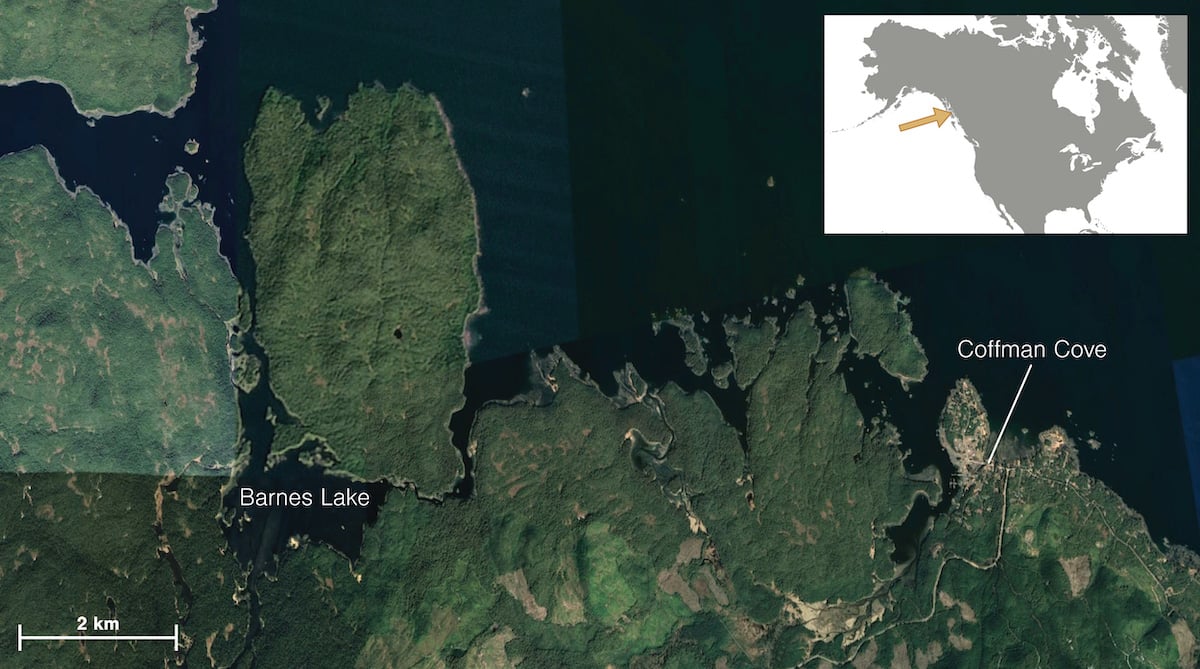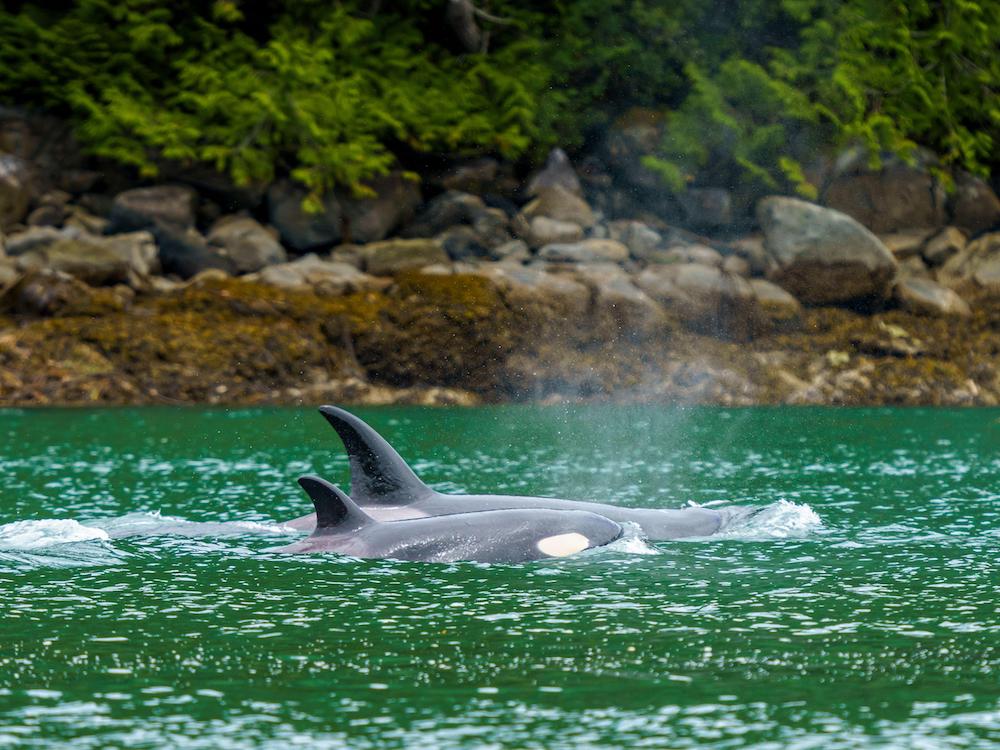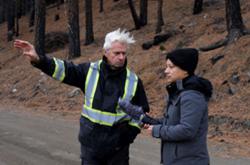[Editor’s note: This article was originally published by Hakai Magazine. Read the original story on their website.]
Killer whales occasionally find themselves where they don’t belong. In the Arctic, they routinely get stuck on the wrong side of encroaching sea ice. Or they swim into an enclosed space at high tide, their escape cut off when the water recedes — as in the case of kʷiisaḥiʔis (Brave Little Hunter), a young female killer whale that recently became trapped in a lagoon in British Columbia.
That’s also what happened last year when two male killer whales inadvertently became imprisoned in Barnes Lake, a tidal lagoon in southeast Alaska.
Although killer whales can often get themselves out of trouble, other times people have to step in to help. And when scientists want killer whales to move — to lead them back to open water or away from an oil spill — what can they do?
For the males stuck in Barnes Lake, scientists led by Fisheries and Oceans Canada, or DFO, ecologist Jared Towers leaned on a novel approach that involved some seemingly irresistible bait: the recorded calls of female killer whales.
The extraordinary rescue attempt began in August 2023, when the two male transient, or Bigg’s, killer whales — a 42-year-old adult and a 16-year-old juvenile — swam up one of two narrow, shallow channels into Barnes Lake, nestled on the northeast corner of Alaska’s Prince of Wales Island. Scientists’ best guess is that the killer whales entered the lake to hunt for harbour seals or sea lions, which, themselves, had been chasing a run of coho salmon.
What began as a curiosity soon turned into a concern. The killer whales faced starvation if they stayed trapped in Barnes Lake and couldn’t find their way back to the Pacific Ocean.

But Towers had an idea. By checking photos of the two male whales against a photo database he keeps for DFO, Towers identified them as T051 and T049A2. The database also tracks the killer whales’ known associates, so he knew that T051 and T049A2 like to travel with five female killer whales that are not maternally related to either of them. With help from his DFO colleague James Pilkington, Towers sourced high-quality recordings of the five female killer whales’ calls.
Towers flew to Alaska with recordings in hand. There, he joined David Bain and Chloe Kotik with the Seattle-based Orca Conservancy and officials with the U.S. National Oceanic and Atmospheric Administration to map out a rescue strategy employing three distinct tactics.
The first two were time-tested strategies. The team assembled a hukilau, to use an ancient Hawaiian fishing method that incorporates lines and floats. They strung a net, about 150 metres long by six metres deep, between two vessels to help herd the whales to freedom.
The second tactic involved hollow metal oikomi pipes, which were lowered into the water and then struck with a hammer to create a loud noise. While oikomi pipes have historically been used to herd cetaceans for slaughter, rescuers have used them to save killer whales before — even in Barnes Lake. In 1994, nine offshore killer whales were stuck in the lagoon for months after chasing a swarm of salmon into the shallow water. During that incident, rescuers used oikomi pipes to lead seven killer whales to safety. Sadly, two of the whales died — one before the rescue attempt and one after.
But this time, researchers added an experimental third weapon to their arsenal: playing killer whale calls through a speaker.
On Sept. 28, 2023, about six weeks after the two male killer whales had first entered Barnes Lake, a flotilla of 14 boats and more than 30 eager locals took to the water.
Lowering a speaker into Barnes Lake from a small boat, Towers broadcast the calls of the five female killer whales. That quickly caught the stranded males’ attention. “They started vocalizing and breaching and were pretty excited,” Towers says. Inching the vessel toward the northerly channel from Barnes Lake, Towers and the flotilla began escorting the males to safety.
Suddenly, the older male became entangled in a mass of bull kelp. He escaped with a powerful pump of his tail and returned to the juvenile male. Together, the pair swam off, circumvented the hukilau net still dangling in the water and returned to Barnes Lake.
That night, the team regrouped to discuss strategy.
The next day, Towers and the other would-be rescuers came back to try again, this time relying only on the recorded whale calls and the hukilau to guide the stranded male whales toward the lake’s easterly channel. It would be tricky. While it has less kelp, the eastern channel is narrower, longer and more winding, with a sharp 90-degree bend.
To succeed, they also had to get the timing just right. The killer whales’ best hope of escape would occur at a high slack tide — when the tidal flow into Barnes Lake is balanced with the outflow from the lake. During this short window, the water in the eastern channel would be at its calmest and deepest — though in one spot the water wouldn’t rise to more than 2.5 metres from the sea floor, not even enough to cover the whales’ dorsal fins. Within minutes, the water level would drop again, and the passage would revert to rapids.
Once more, Towers submerged his speaker from the small boat and played short bursts of the female killer whales’ calls. It worked.
“They came right for the source of the playback,” he says. “We entered the exit channel, and they were right behind us.”
The rest of the rescue team remained in the lake with the hukilau as a backup in case the whales turned around, but that never happened.
With the boat staying 25 to 100 metres ahead, the killer whales picked up speed as the channel widened and continued out into Lake Bay, Clarence Strait, and to safety.
“Once inside, they were committed. It was like a trail of acoustic bread crumbs,” Towers says.
Jubilation echoed across the water. Citizens from nearby Coffman Cove who’d helped in the rescue, including sport and commercial fishers, hooted and hollered into marine radios. Some were brought to tears. “It felt great — very validating,” Towers says. Later that day, drinks flowed at the Dog House bar, and stories raged into the night.
Callbacks don’t always work
Despite the happy ending, Towers is guarded about what he says remains a highly experimental tactic.
Luring Bigg’s killer whales using the recorded calls of other Bigg’s whales had been done twice before in British Columbia. The first was in 2013 when a young male became trapped on the province’s north coast. The second was in 2018 when rescuers lured a large male killer whale out of Comox Harbour on the east coast of Vancouver Island, where it had become a nuisance to vessels and fishing gear.
In the recent case of two-year-old kʷiisaḥiʔis, or T109A3A, Towers tried to coax her from the lagoon she was trapped in by playing callbacks from other whales, including her great-aunt. But the little whale didn’t fall for it.
“I have no idea why they didn’t work, but it really highlights how experimental this approach is,” Towers says. The whale escaped on its own at high tide on April 26, 2024, after more than a month in the lagoon.
Like Towers, other researchers are cautious about broadcasting animal calls into the wild.
“Playback is a really powerful tool because it allows you to modify the behaviour of these animals,” says Volker Deecke, a conservation biologist at the University of Cumbria in England, who began studying acoustic communication in killer whales on the B.C. coast as a graduate student. “But you have to get the context right. It is also potentially risky because if you get it wrong, and you play, say, an aggressive sound, you may actually be driving the whales toward a danger.”
Deecke, who did not participate in the Barnes Lake rescue, says that attempting even this imperfect mode of communication should be easier with killer whales in the North Pacific than with other populations because they’ve been closely studied for decades.
“We know every individual killer whale, its social history and what social group it comes from,” says Deecke. “We can choose very specific stimuli that we know will have a high likelihood of success.”
Towers agrees the approach is imperfect and bears some risk: “We don’t really know what we’re playing back. It’s an educated guess.”
Fortunately, for the two males trapped in Barnes Lake, it was an educated guess that worked. ![]()
Read more: Science + Tech, Environment

















Tyee Commenting Guidelines
Comments that violate guidelines risk being deleted, and violations may result in a temporary or permanent user ban. Maintain the spirit of good conversation to stay in the discussion and be patient with moderators. Comments are reviewed regularly but not in real time.
Do:
Do not: